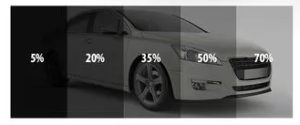Window Tint Laws in Illinois, how dark is too dark?
While window tint has tons of benefits, it’s important to stay on the right side of the law when it comes to how dark you go with your tint. The last thing you want is to be driving a vehicle with an illegal amount of tint. So how dark is too dark in Illinois?
Well to start, Illinois window tint laws are some of the strictest regulations in the United States and are not exactly intuitive. Illinois has different rules depending on the vehicle and the areas of the car you are applying the tint.
Illinois Window Tint Law
One of the most important things to know when it comes to window tint is how it is measured. This determines how much you can tint your windows and whether or not you’ll get pulled over and ticketed for having an illegal tint level.
ln Illinois window tint is measured in VLT or visible light transmission percentage. VLT determines how much light can get through the film and glass. A higher VLT allows more light to pass through, while a lower VLT lets less light in. The lower the VLT, the darker the tint. The exact legal VLT depends on the type of vehicle you drive and which windows you are tinting, with different rules for windshield versus side windows.
Passenger Vehicles vs. Multi-Purpose Vehicles
Passenger vehicles include sedans, coupes, convertibles, station wagons, hardtops, and hatchbacks. Basically, if your standard vehicle is used to transport a single person and/or their family from place to place.
Multi-purpose vehicles include SUVs, pickups, vans, RVs, and minibusses. Heavy-duty vehicles that can transport both groups of people and materials.
These two groups of vehicles perform different functions, which is why Illinois window tint law sets separate regulations for each. The tint levels that are legal for one may not be for another, so you need to know the numbers for both.
Passenger Vehicles
|
Multi-Purpose Vehicles
|
Medical Exemptions
But what if you want a darker tint that you are allowed to have. Well, there is an exception, the medical exemption. The medical exception allows you have a special level of tint.
To receive a medical exemption you must:
- Obtain a certified letter or statement from a licensed physician. It must prove that you have a qualifying condition i.e systemic or discoid lupus erythematosus, disseminated superficial actinic porokeratosis, or albinism to name a few
- The medical condition can not be relieved by wearing sunglasses or other protective eye devices
- Renew your certification every 4 years
Penalties
Window tints provide a wide range of benefits. They reduce UV exposure, keep your upholstery looking like new, shatterproof your windows, increase security, privacy, and safety, and reduce heat.
Despite these advantages, a tint that’s too dark can cause safety issues and can put you on the radar of police officers. If an officer pulls you over and feels that your tint is too dark; they can use a device known as a tint meter to determine how much light passes through a car’s window. If it’s not the right amount, they can ticket you.
Tickets can range from $50-$500 for a first offense, to $100-$500 for repeated offenses.
Where Can I Get My Windows Tinted in Illinois?
You can trust 618 Dent Guy to darken your windows to legal levels and safely provide you with all the increased confront of a good tint. Get a window tinting estimate or contact us today for more information.





